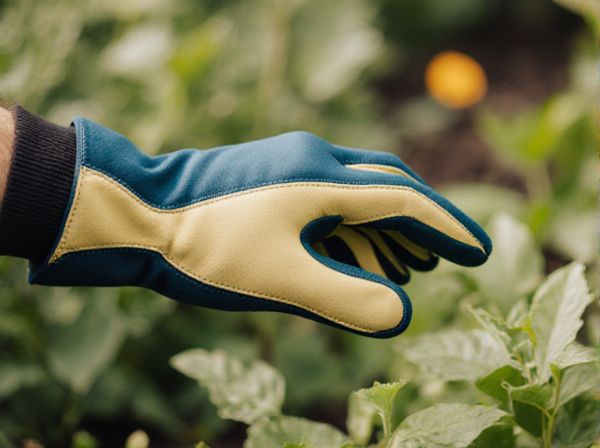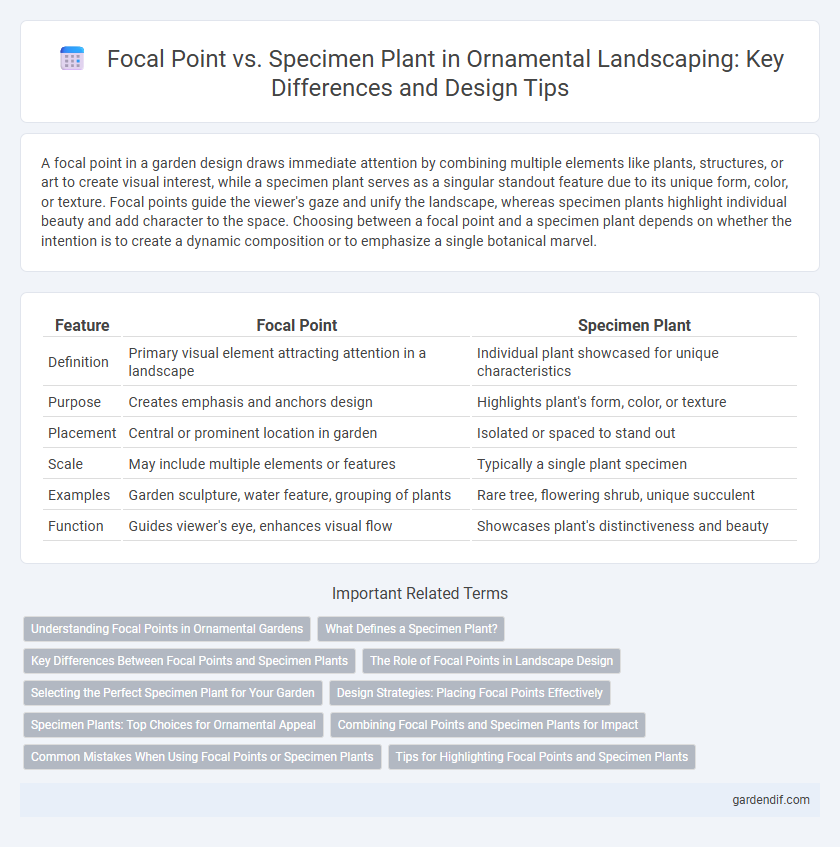
Focal Point vs Specimen Plant Illustration
A focal point in a garden design draws immediate attention by combining multiple elements like plants, structures, or art to create visual interest, while a specimen plant serves as a singular standout feature due to its unique form, color, or texture. Focal points guide the viewer's gaze and unify the landscape, whereas specimen plants highlight individual beauty and add character to the space. Choosing between a focal point and a specimen plant depends on whether the intention is to create a dynamic composition or to emphasize a single botanical marvel.
Table of Comparison
| Feature | Focal Point | Specimen Plant |
|---|---|---|
| Definition | Primary visual element attracting attention in a landscape | Individual plant showcased for unique characteristics |
| Purpose | Creates emphasis and anchors design | Highlights plant's form, color, or texture |
| Placement | Central or prominent location in garden | Isolated or spaced to stand out |
| Scale | May include multiple elements or features | Typically a single plant specimen |
| Examples | Garden sculpture, water feature, grouping of plants | Rare tree, flowering shrub, unique succulent |
| Function | Guides viewer's eye, enhances visual flow | Showcases plant's distinctiveness and beauty |
Understanding Focal Points in Ornamental Gardens
Focal points in ornamental gardens serve as visual anchors that draw the eye and create a structured landscape design, contrasting with specimen plants which are featured individually for their unique characteristics. Effective focal points often combine multiple plants, garden art, or landscape elements to establish balance and interest. Understanding how to position and select focal points enhances garden aesthetics by guiding movement and emphasizing key areas.
What Defines a Specimen Plant?
A specimen plant is defined by its unique form, striking appearance, and ability to stand out as a singular focal point in a landscape or garden setting. Unlike general focal points that guide visual interest, specimen plants possess distinctive characteristics such as unusual foliage, vibrant color, or extraordinary size that command attention independently. These plants are often rare or exotic species selected specifically to showcase their ornamental value and create an impactful visual statement.
Key Differences Between Focal Points and Specimen Plants
Focal points in landscaping are designed to draw immediate attention using elements like bold colors or unique shapes, while specimen plants serve as standout examples of a species known for exceptional form or rarity. The primary difference lies in purpose: focal points create visual interest and guide the viewer's eye, whereas specimen plants emphasize horticultural value and showcase plant characteristics. Understanding these distinctions helps in strategic garden design, enhancing both aesthetic appeal and botanical significance.
The Role of Focal Points in Landscape Design
Focal points in landscape design serve as intentional visual anchors that draw attention and create a sense of balance, guiding viewers through the space while enhancing overall aesthetics. Unlike specimen plants, which showcase individual botanical features, focal points integrate various elements such as sculptures, water features, or groups of plants to establish hierarchy and emphasize key areas. Effective use of focal points transforms ordinary gardens into captivating environments by strategically highlighting specific zones and creating memorable visual experiences.
Selecting the Perfect Specimen Plant for Your Garden
Choosing the perfect specimen plant for your garden involves selecting a unique, eye-catching plant that serves as a focal point due to its size, color, or texture distinction. Unlike general focal points that may include multiple plants or garden features, a specimen plant stands alone, highlighting its individual beauty and enhancing garden aesthetics. Prioritize species with striking attributes such as bold foliage, vibrant blooms, or architectural shapes to create a dramatic and memorable garden centerpiece.
Design Strategies: Placing Focal Points Effectively
Effective landscape design leverages focal points and specimen plants to create visual interest and balance, guiding the viewer's eye through the space. Focal points serve as anchor elements, often positioned at key sightlines or intersections, while specimen plants highlight unique textures, colors, or forms to draw attention. Strategic placement involves considering scale, contrast, and surrounding plantings to ensure focal elements stand out without overwhelming the overall composition.
Specimen Plants: Top Choices for Ornamental Appeal
Specimen plants serve as striking standalone features, offering unique shapes, colors, and textures that enhance garden aesthetics more distinctly than general focal points. Ideal choices include Japanese maples, bird-of-paradise, and hydrangeas, each providing dramatic visual interest and seasonal variety. Their strategic placement highlights architectural beauty while creating natural emphasis in landscape designs.
Combining Focal Points and Specimen Plants for Impact
Combining focal points and specimen plants enhances garden design by creating visually striking areas that draw attention and showcase unique plant characteristics. Focal points often serve as anchors with architectural elements or groups of plants, while specimen plants provide standout features due to their distinct form, color, or size. Strategically placing specimen plants near focal points amplifies impact, guiding the eye and adding depth to the landscape composition.
Common Mistakes When Using Focal Points or Specimen Plants
Common mistakes when using focal points or specimen plants include choosing species that lack year-round interest or fail to contrast with surrounding vegetation, diminishing their visual impact. Overloading a space with multiple focal points can create confusion rather than emphasis, reducing overall garden coherence. Neglecting the scale and placement relative to sightlines often results in focal points that are either overwhelming or inconspicuous, undermining their intended purpose in landscape design.
Tips for Highlighting Focal Points and Specimen Plants
To effectively highlight focal points and specimen plants, use contrasting textures and colors to draw attention, ensuring the surrounding plants provide a complementary backdrop without overwhelming the main feature. Strategic lighting, such as spotlights or uplighting, enhances visibility and adds drama during evening hours, emphasizing the unique characteristics of the specimen plant. Incorporate hardscape elements like decorative pots, rocks, or mulch rings to frame focal points, creating a defined and visually appealing area that guides the viewer's eye.
Focal Point vs Specimen Plant Infographic

 gardendif.com
gardendif.com